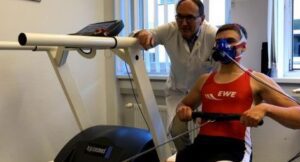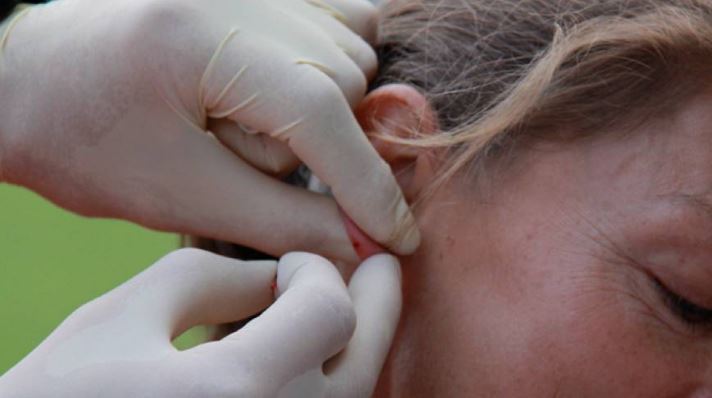We have all heard of it. Be it at the beginning of the rowing season in spring, or at the start of the handball or soccer league – the lactate test. But what exactly is lactate, and what is the goal of a lactate test for rowers? We will answer this question for you in the following article!

What is lactate and why is it important?
Simply put, lactate is a metabolic product. The body has various energy systems at its disposal, which it constantly draws on. Depending on the intensity and length of an athletic effort, these systems provide different amounts of energy. One of these systems is the so-called lactacide-anaerobic metabolism. A process in which sugar is broken down into lactic acid in the muscle without the supply of oxygen. This process releases a great deal of energy in a short time. If the effort is reduced, the lactate is broken down again.
What is a lactate test?
The lactate test is an endurance performance test for athletes. The lactate value in the blood provides information about where a person’s performance limit lies. For more than 50 years, it has been one of the standards in performance diagnostics: rowers undergo the little sting in the earlobe just like professional soccer players or swimming stars.
The lactate values in the blood can be used to determine where the performance limits lie. In order to be able to tailor training units even more individually, sports physicians are researching more precise parameters. Before each Olympic Games, World Championships and European Championships, the national team contenders have to fight for their nomination. Not only rowing in various team boats, but also an extensive performance test decides who will be included in the squad. The test – developed in Germany and today a worldwide standard – offers the following advantages:
- Optimal control over your performance development through effective training planning.
- Objective overview of training success through performance comparison before – after.
- Train with certainty in the ideal heart rate range through an exact determination of your training / metabolic ranges.
- Healthy, sustainable training by avoiding overtraining.
How is a lactate test done?
William C. Hilberg and also the rowing association RISH wrote about it some time ago: For the lactate test, the subject has to train in stages on a suitable ergometer or treadmill. At the end of each stage, a small drop of blood is taken from the finger or earlobe to determine the lactate. A very good overview can be found in the documents of Swiss Olympics.
Phase 1 Preparation
Do not train on the day before the test and on the test day itself!
- Sleep in! No parties / alcohol consumption the night before the test!
- You should have your last meal 3 hours before the test! If you have a snack before your normal training sessions, you may also do so before the test.
- Do not consume caffeine, nicotine, alcohol, fruit juices or other sugared drinks 2-3 hours before the test!

(Foto Credit: MWZ)
Phase 2 Discussion and check-up documentation
How does the test person assess his current performance level?
- How many times a week and at what heart rate has training been done so far?
- Personal goals and wishes.
- General state of health
- Risk factors (cardiovascular problems, medication, etc.)
Documentation of anthropometric data
- Height and weight
- Blood pressure
- Resting pulse
- Blood glucose
- BMI
- Body fat and skeletal muscle mass, etc.
Phase 3 – Procedure of the lactate test
Determination of the lactate levels in the individual training stages by taking a blood sample from the finger / ear lobe.
- The test person starts to pull/pedal on the pedals or the ergometer and tries to keep a constant frequency. The body position on the ergometer should also not be changed significantly. Now a continuous, gradual increase in the training stages takes place up to the exhaustion.
- At the end of each stage, the blood lactate level is determined by taking a blood sample from the earlobe or finger. At the same time, the heart rate is measured and recorded.
Phase 4 Evaluation and debriefing
A heart rate-lactate curve is created from the test data, i.e. the lactate concentration is set in relation to the training stage. From the curve, the aerobic and individual anaerobic threshold (IANS) of the test person can now be determined. With this data, a training plan – adapted to the athlete – can be developed, and the performance can be compared with that of other athletes.
Based on various values, the individual training areas can be derived, among other things, and thus an efficient and healthy increase in performance can be achieved.
Lactate test for rowers – Only for competitive athletes?
Even if we always associate a lactate test only with competitive athletes, such a test can also make sense for amateur athletes who want to increase their performance. However, it is always important to set realistic goals and maintain the right sense of proportion. In addition, you should discuss any measures with your coach and doctor. Even though there are many providers of performance tests for amateur athletes nowadays, this does not mean that they also have a medical background. And a performance test only makes sense if you discuss your training and possible performance improvements with your coach.







